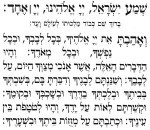Teeth in the Shema – Ask the Rabbi
 Q. The word v’shinnantam in the Shema puzzles me. The translation says, “you shall teach them diligently”, but the Hebrew seems to be connected with the word for a tooth, shen.
Q. The word v’shinnantam in the Shema puzzles me. The translation says, “you shall teach them diligently”, but the Hebrew seems to be connected with the word for a tooth, shen.
A. The word (the reference is Deut. 6:7) derives from the verb shanah, to repeat, and therefore to learn by repetition. But some connect it with shen, a tooth; teaching diligently certainly implies biting deeply like teeth into a subject.
Rashi says it is an expression for chiddud, being sharply impressed. In the Talmud a certain sage with an incisive mind is called shin’na, a man with prominent teeth (Hag. 15b).
Rabbinic literature mentions teeth in a number of other metaphorical contexts. Teeth symbolise friendship: “He who smilingly shows his teeth to his fellow is better than one who (reluctantly) gives him milk to drink” (Ket. 111b, based on Gen. 49:12).
From teeth we learn the blessing of peace: teeth are dangerous like a sword, and better than turning your teeth or sword upon a person or nation is to beat your swords into ploughshares and your spears into pruning-hooks (Job. 16:9; 35:16, 58:7, 1245:6; Isa. 2:4; Mic. 4:6).
To provoke or irritate a person is to set their teeth on edge: this what we have to do (hak’heh et shinav) to the wicked son in the Haggadah (see Jer. 31:29).



